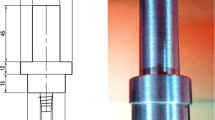Abstract
The effect of process parameters on vertical forces and temperatures developed during friction stir welding of AZ31 magnesium alloy sheets was widely investigated. To this end, friction stir welding (FSW) experiments were carried out with constant values of the rotational and welding speeds in the ranges from 1200 to 2500 rpm and from 30 to 100 mm/min, respectively. The influence of the time between the end of the sinking stage and the beginning of the welding one was also studied using dwelling time values ranging from 0 to 120 s. Vertical forces occurring during all stages of FSW were measured using a low-cost dynamometer developed by authors. Furthermore, temperatures in different positions of the welding line were monitored by means of K-type thermocouples. It was shown that during the dwelling stage, the vertical force decreases until a steady-state regime is reached. However, the dwelling time does not significantly affect the force value in the welding stage. The vertical force versus time curve promptly reaches a steady state during the welding stage. The force value rises with increasing welding speed and decreasing rotational speed; such effect is consistent with the one showed by rotational and welding speeds on temperature measured in different positions during FSW. Finally, forces and temperatures have been related to the mechanical properties of the joints. It was shown that both the ultimate tensile strength and ultimate elongation exhibit the highest values under the process parameters leading to the lowest vertical force and highest welding temperature.
Similar content being viewed by others
References
Mishra RS, Ma ZY (2005) Friction stir welding and processing. Mater Sci Eng R 50:1–78. doi:10.1016/j.mser.2005.07.001
Nandan R, DebRoy T, Bhadeshia HKDH (2008) Recent advances in friction-stir welding—process, weldment structure and properties. Prog Mater Sci 53:980–1023. doi:10.1016/j.pmatsci.2008.05.001
Kinsey B, Viswanathan V, Cao J (2001) Forming of aluminum tailor welded blanks. SAE Technical Paper 673–679. doi:10.4271/2001-01-0822
Forcellese A, Simoncini M (2012) Plastic flow behaviour and formability of friction stir welded joints in AZ31 thin sheets obtained using the “pinless” tool configuration. Mater Des 36:123–129. doi:10.1016/j.matdes.2011.11.017
Bruni C, Forcellese A, Gabrielli F, Simoncini M (2011) Post-welding formability of AZ31 magnesium alloy. Mater Des 32(5):2988–2991. doi:10.1016/j.matdes.2011.01.004
Stasik MC, Wagoner RH (1996) Forming of tailor welded aluminum blanks. Aluminum and magnesium for automotive applications, The Minerals, Metals & Materials Society 69–83
Xu WF, Liu JH, Chen DL, Luan GH (2014) Low-cycle fatigue of a friction stir welded 2219-T62 aluminum alloy at different welding parameters and cooling conditions. Int J Adv Manuf Technol 74:209–218. doi:10.1007/s00170-014-5988-z
Sakthivel T, Sengar GS, Mukhopadhyay J (2009) Effect of welding speed on microstructure and mechanical properties of friction-stir-welded aluminum. Int J Adv Manuf Technol 43:468–473. doi:10.1007/s00170-008-1727-7
Buffa G, Ducato A, Fratini L (2011) Numerical procedure for residual stresses prediction in friction stir welding. Finite Elem Anal Des 47:470–476. doi:10.1016/j.finel.2010.12.018
Zimmer S, Langlois L, Laye J, Goussain J-C, Martin P, Bigot R (2009) Influence of processing parameters on the tool and workpiece mechanical interaction during friction stir welding. Int J Mater Form 2(1):299–302. doi:10.1007/s12289-009-0496-7
Su H, Wu CS, Pittner A, Rethmeier M (2013) Simultaneous measurement of tool torque, traverse force and vertical force in friction stir welding. J Manuf Process 15:495–500. doi:10.1016/j.jmapro.2013.09.001
He X, Gu F, Ball A (2014) A review of numerical analysis of friction stir welding. Prog Mater Sci 65:1–66. doi:10.1016/j.pmatsci.2014.03.003
Astarita A, Squillace A, Carrino L (2014) Experimental study of the forces acting on the tool in the friction-stir welding of AA 2024 T3 sheets. J Mater Eng Perform 23(10):3754–3761. doi:10.1007/s11665-014-1140-3
Gemme F, Verreman Y, Dubourg L, Jahazi M (2010) Numerical analysis of the dwell phase in friction stir welding and comparison with experimental data. Mater Sci Eng A 527:4152–4160. doi:10.1016/j.msea.2010.03.026
Simoncini M, Cabibbo M, Forcellese A (2015) Development of double-side friction stir welding to improve post-welding formability of joints in AA6082 aluminium alloy. Proc Inst Mech Eng B J Eng Manuf 1–11. doi:10.1177/0954405414560618
Forcellese A, Martarelli M, Pandarese G, Simoncini M (2013) Similar and dissimilar FSWed joints in lightweight alloys: heating distribution assessment and IR thermography monitoring for on-line quality control. Key Eng Mater 554–557:1055–1064. doi:10.4028/www.scientific.net/KEM.554-557.1055
Trimble D, Monaghan J, O’Donnell GE (2012) Force generation during friction stir welding of AA2024-T3. CIRP Ann Manuf Technol 61:9–12. doi:10.1016/j.cirp.2012.03.024
Janaki Ramulu P, Ganesh Narayanan R, Kailas SV, Reddy J (2013) Internal defect and process parameter analysis during friction stir welding of Al 6061 sheets. Int J Adv Manuf Technol 65:1515–1528. doi:10.1007/s00170-012-4276-z
Author information
Authors and Affiliations
Corresponding author
Rights and permissions
About this article
Cite this article
Forcellese, A., Martarelli, M. & Simoncini, M. Effect of process parameters on vertical forces and temperatures developed during friction stir welding of magnesium alloys. Int J Adv Manuf Technol 85, 595–604 (2016). https://doi.org/10.1007/s00170-015-7957-6
Received:
Accepted:
Published:
Issue Date:
DOI: https://doi.org/10.1007/s00170-015-7957-6




